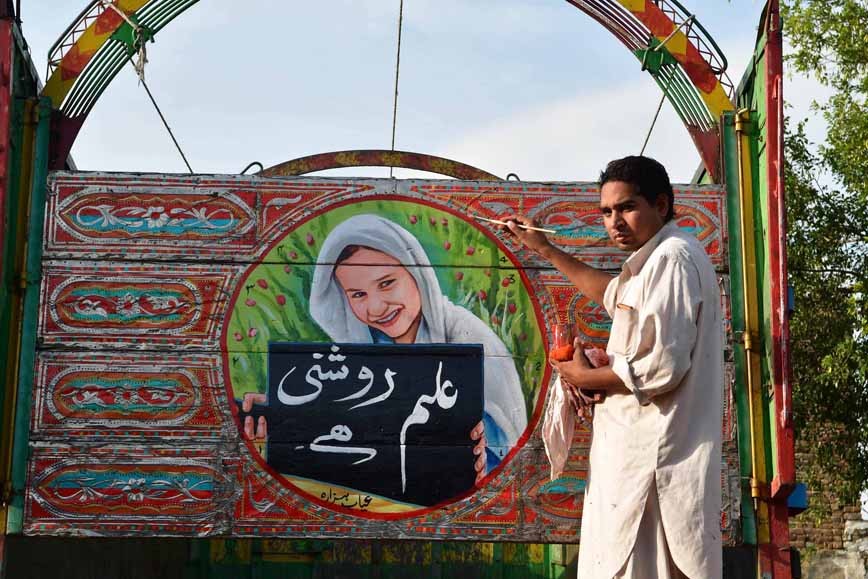
An initiative that spreads pro-girls’ education slogans via truck art is hoping to change mindsets in Kohistan and around the country

Fantastical figures that are half-human, half-animal, scenes of vibrantly coloured roses and pine trees, and famous truck poetry with witty couplets that mostly don’t rhyme. Pakistan’s truck art is a part of our cultural heritage, appropriated by designers in various forms. But now, in Khyber-Pakhtunkhwa’s Kohistan district, truck art is serving more than the purpose of being just visually pleasing. Trucks here are becoming vehicles for spreading awareness regarding educating girls, and truck art is making its way to bridges and classrooms with messages like Baba, mujhay sona aur chaandi nahin, kitaab aur qalam la kar do (Father, don’t bring me silver or gold, but bring me a book and a pen), Ilm taaqat hai, Ilm roshni hai (knowledge is power, knowledge is light) and Kitaabain ghar ka chiraagh hain (Books are the lamps that light up a house).
"It’s an initiative that I am so proud of because the local community has owned it," says documentary filmmaker and rights activist Samar Minallah who developed the concept of a culturally relevant advocacy initiative through truck art. "The brightly painted trucks are like moving billboards that amplify a message from one part of Pakistan to another. My visit to Kohistan further reinforced my belief in using art and traditional motifs and designs for raising awareness," says Minallah. Kohistan, according to the Alif Ailaan Pakistan Education District ranking 2015, is the worst performing district educationally in KP.
Using indigenous sensitivities and art in mind, Minallah interviewed local people for their opinion and collected local embroidery motifs created by village women as the preparatory research for the project, to incorporate in the final drawings and paintings. "The aim was to not only raise awareness about the importance of education for girls but also to honour local art and crafts, and develop a sense of ownership for the local community members," she says. The total number of trucks that have been painted till now with these messages is 30.
"The feedback has been great because indigenous art and tools were used to convince local communities about the importance of education for girls, so it found acceptance and appreciation," said Dr Ziaur Rehman Faruqi who is Head of Programmes at National Integrated Development Association (NIDA), and is actively involved with the project ‘Girls Right to Education’ in collaboration with UNESCO and both the federal and provincial governments. In the spirit of collaborative efforts, Faruqi shared that they have brought on board not just local leaders and parents but also the religious clergy and the political leadership for what he called a "holistic approach". "This could not have been achieved otherwise as Kohistan had multiple issues like ghost schools and teachers."
According to local teachers, children of primary schools of Pattan look forward to attending their newly painted classrooms decorated with bright indigenous symbols from Kohistan, shares Minallah, adding that truck owners from Punjab have reached out to the artists to have their trucks painted with similar images and messages. "One of the local mosque imams asked if his mosque’s name could also be added on the newly painted bridge along with the pro-education empowering messages," she says. Local people take selfies and photos from their mobile phones in front of these bridges of Sholgara, Dubair and Bisham adorned with important messages such as
Bhai aur behen mil kar school jaain, Zindagi main ilm se roshni jalaain (Both brother and sister should go to school and bring to life the light of knowledge) and Apni aulaad ko taleem ka tohfa daen (Give your children the gift of education).
Atif Khan, Minister for Education, KP, shares how education of girls is now being seen as a priority. "We are especially working on education for girls. Examples are that 70 per cent of all new schools we are working on are schools for girls, and also 70 per cent of the work to provide missing facilities in schools is focused on facilities for girls," he says. As an incentive, female education managers in backward districts like Kohistan are being paid 50 per cent extra. Lauding the initiative to sensitize communities towards the right of education for girls through truck art, the minister said that traditions don’t change overnight. "Just constructing schools and passing bills is not enough. It is the mindsets that have to be worked on."
"Work on this project has made me happy. It made the girls and their teachers happy. The classrooms looked beautiful. The girls would join in painting with me," said Shaukat Khan, the painter who has till now painted these positive messages with colourful drawings on three bridges and eight classrooms in far-flung parts of Kohistan. "Initially the locals resisted. They were even upset. But once they saw the finished work, they began to like the idea. Change is starting to happen," said Khan. Khan, a father of four daughters and one son, is an artist from Swat, who has made sure his daughters are going to school "because girls must get an education".